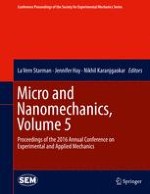2017 | Buch
Micro and Nanomechanics, Volume 5
Proceedings of the 2016 Annual Conference on Experimental and Applied Mechanics
herausgegeben von: La Vern Starman, Jennifer Hay, Nikhil Karanjgaokar
Verlag: Springer International Publishing
Buchreihe : Conference Proceedings of the Society for Experimental Mechanics Series
